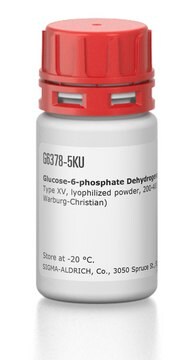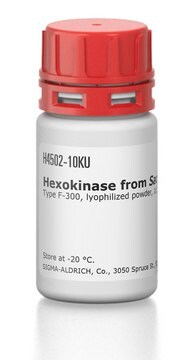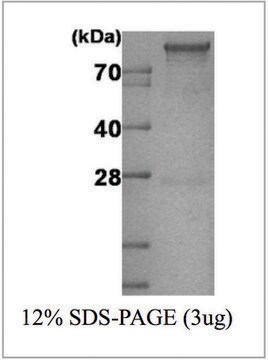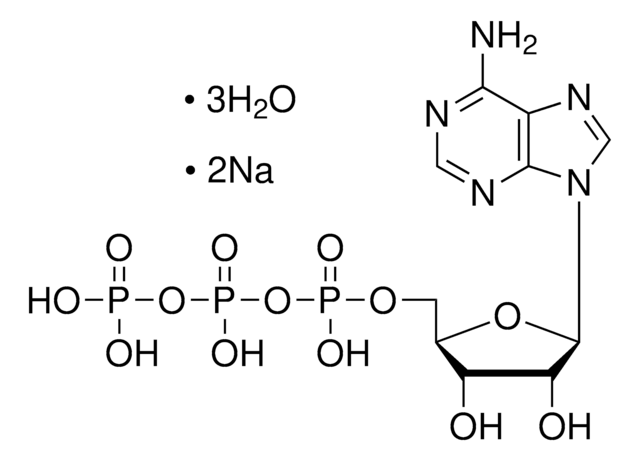Alle Fotos(1)
Wichtige Dokumente
HKG6PDH-RO
Roche
Hexokinase/Glucose-6-Phosphat-Dehydrogenase (HK/G6P-DH)
from yeast/Leuconostoc, overproducer
Synonym(e):
G6P-DH, Glucose-6-phosphat-DehydrogenaseHK, Hexokinase
Anmeldenzur Ansicht organisationsspezifischer und vertraglich vereinbarter Preise
Alle Fotos(1)
About This Item
UNSPSC-Code:
12352204
Empfohlene Produkte
Biologische Quelle
yeast
Qualitätsniveau
Form
suspension
Mol-Gew.
dimer 110,000 Da
Verpackung
pkg of 10 mL (10737275001 [30 mg])
pkg of 5 mL (10127825001 [15 mg])
Hersteller/Markenname
Roche
Konzentration
3.21 mg/mL
Methode(n)
activity assay: suitable
Farbe
white
pH-Wert
5.5-6.5
Löslichkeit
water: miscible
Eignung
suitable for UV spectrophotometry and general use
Anwendung(en)
life science and biopharma
Lagertemp.
2-8°C
Allgemeine Beschreibung
Hexokinase dient dazu, den ersten Schritt der Glykolyse zu katalysieren. Dabei entsteht Glucose-6-Phosphat und ADP aus Glucose und ATP. Glucose-6-Phosphat-Dehydrogenase ist ein entscheidendes Enzym im Pentose-Phosphat-Wirkungsweg. Sie ist verantwortlich für die Umwandlung von Glucose-6-Phosphat und NADP+ (Nicotinamid-Adenin-Dinukleotidphosphat) in 6-Phosphogluconolakton und NADPH.
Anwendung
Hexokinase/Glucose-6-Phosphat-Dehydrogenase wurde zur Bestimmung der Plasmaglucosespiegel verwendet.
Komponenten
EC 2.7.1.1 & 1.1.1.49
Einheitendefinition
Eine Einheit (U) HK phosphoryliert 1 μmol D-Glucose bei +25 °C und einem pH-Wert von 7,6 in einer Minute.
Eine Einheit (U) G6P-DH oxidiert 1 μmol Glucose-6-Phosphat bei +25 °C und einem pH-Wert von 7,6 in einer Minute.
Der gekoppelte Assay erzeugt 1 μmol NADH pro μmol D-Glucose phosphoryliert.
Volumenaktivität: 340 U Hexokinase/mL bei +25 °C mit Glucose und ATP als Substrat. 170 U Glucose-6-Phosphat-Dehydrogenase/ml bei +25 °C mit Glucose-6-Phosphat als Substrat.
Eine Einheit (U) G6P-DH oxidiert 1 μmol Glucose-6-Phosphat bei +25 °C und einem pH-Wert von 7,6 in einer Minute.
Der gekoppelte Assay erzeugt 1 μmol NADH pro μmol D-Glucose phosphoryliert.
Volumenaktivität: 340 U Hexokinase/mL bei +25 °C mit Glucose und ATP als Substrat. 170 U Glucose-6-Phosphat-Dehydrogenase/ml bei +25 °C mit Glucose-6-Phosphat als Substrat.
Physikalische Form
Suspension in 3,2 M Ammoniumsulfatlösung, pH-Wert ca. 6. Hergestellt durch Mischen von Hexokinase mit G6P-DH. HK: G6P-DH etwa 2:1 im Hinblick auf den Proteingehalt.
Sonstige Hinweise
Nur für die Life-Science-Forschung. Nicht zur Verwendung in diagnostischen Verfahren vorgesehen.
Lagerklassenschlüssel
12 - Non Combustible Liquids
WGK
WGK 1
Flammpunkt (°F)
does not flash
Flammpunkt (°C)
does not flash
Hier finden Sie alle aktuellen Versionen:
Besitzen Sie dieses Produkt bereits?
In der Dokumentenbibliothek finden Sie die Dokumentation zu den Produkten, die Sie kürzlich erworben haben.
Kunden haben sich ebenfalls angesehen
H Pelicano et al.
Oncogene, 25(34), 4633-4646 (2006-08-08)
Most cancer cells exhibit increased glycolysis and use this metabolic pathway for generation of ATP as a main source of their energy supply. This phenomenon is known as the Warburg effect and is considered as one of the most fundamental
Miguel Vázquez-Velasco et al.
Nutricion hospitalaria, 32(6), 2718-2724 (2015-12-17)
Type 2 diabetes is a very prevalent chronic disease. Among dietary factors for its prevention and treatment, interest has grown in satiating fibre (konjac glucomannan) and spirulina. Our previous studies suggest that glucomannan itself and/or in conjunction to spirulina displayed
K Gottlob et al.
Genes & development, 15(11), 1406-1418 (2001-06-08)
The serine/threonine kinase Akt/PKB is a major downstream effector of growth factor-mediated cell survival. Activated Akt, like Bcl-2 and Bcl-xL, prevents closure of a PT pore component, the voltage-dependent anion channel (VDAC); intracellular acidification; mitochondrial hyperpolarization; and the decline in
Robert C Stanton
IUBMB life, 64(5), 362-369 (2012-03-21)
Glucose-6-phosphate dehydrogenase (G6PD) is the rate-limiting enzyme of the pentose phosphate pathway. Many scientists think that the roles and regulation of G6PD in physiology and pathophysiology have been well established as the enzyme was first identified 80 years ago. And
Unser Team von Wissenschaftlern verfügt über Erfahrung in allen Forschungsbereichen einschließlich Life Science, Materialwissenschaften, chemischer Synthese, Chromatographie, Analytik und vielen mehr..
Setzen Sie sich mit dem technischen Dienst in Verbindung.









